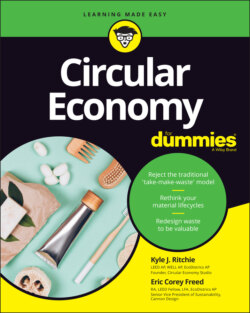Читать книгу Circular Economy For Dummies - Eric Corey Freed - Страница 84
From Linear To Circular: What You Need To Know
ОглавлениеIN THIS CHAPTER
Understanding the key differences between a linear and circular economy
Identifying how waste from one system can become a resource for another
Investigating how resilience influences the circular economy
When scientists drop the scary-sounding term entropy into a conversation, all they’re doing is describing the amount of waste or disorder in a system. Even within the most efficient circular systems — like the ones this book is focused on — waste and disorder will exist. And it has to exist, because waste is a vital component of the second law of thermodynamics. If you paid attention in physics class, you’ll remember that this second law addresses the irreversibility of natural processes and the limitation of efficiency. Does it ring a bell? No? Okay, well, for those of you who passed notes during physics class, the idea here is that there's a limit to how efficiently energy can be transferred between systems — waste will always exist, most commonly as heat loss. This is why neither a fully circular economy nor a perpetual motion device will ever exist. Wait — you might believe that this statement massively contradicts the intentions of this book, but we promise you, you would be wrong.
Most people grow up believing that waste is just something that goes “away,” right? You put your white, plastic trash bag in the garbage can and some big, diesel-powered truck magically removes it from your life to a faraway land. But that’s the wrong way to look at waste, and, honestly, that perspective is responsible for why the world is in the pickle it’s in today. Waste — or the energy that will inevitably leave a system — doesn’t need to be piled a mile high in a landfill. It doesn’t even need to go away. We’re wasting precious resources every time it does go away. If we humans redefine what waste means to us, acknowledge that it doesn’t need to exist, and redirect it based on how energy flows occur in nature — as food for another system— we can eliminate pollution and the natural tendencies of entropy.
This idea that waste equals food is clearly identifiable within the natural world. A leaf, for example, acts as an energy collection source for the tree, eventually falls gently to the ground, and then becomes a habitat and/or food source for a wide variety of little critters. Insects in the soil then consume the leaf matter and convert its material back to nutrients that provide the tree with what it needs in order to grow new leaves. Waste = Food. It's as simple as that. Imagine if insects decided to instead collect all the leaves and pile them up far away. Would the trees suffer or flourish? What if insects had landfills?
